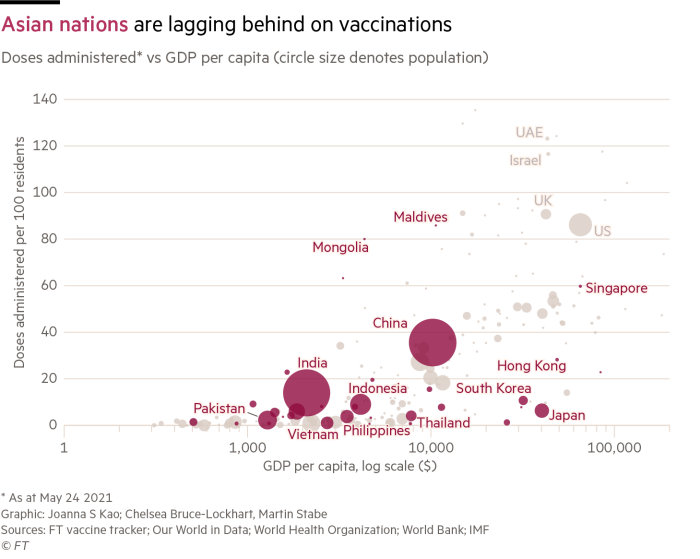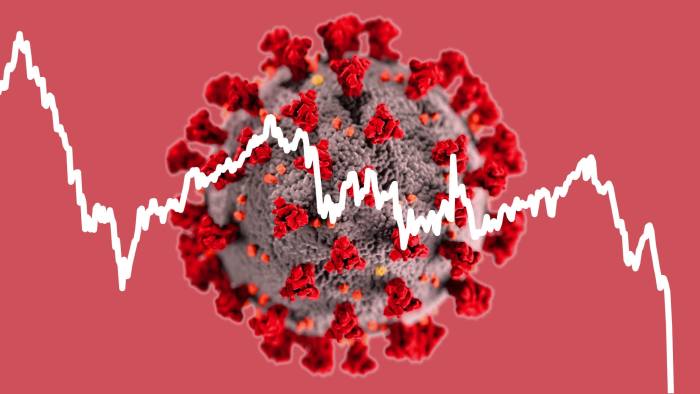
Asia’s curious struggle to vaccinate its citizens
Asian countries that led the way in controlling Covid-19 last year have become laggards in the battle against the virus as their efforts to vaccinate their populations fall behind other parts of the world.
The problems with rollout vary from country to country, but across most of Asia one factor is constant: a lack of vaccines to administer. Having failed to develop or produce vaccines at home, many Asian countries must wait for deliveries from Europe or the US, leaving them at the back of the queue.
While Asia has become the factory of the world, making up an increasingly dominant share of the global economy, the race for vaccines has shown it still lags behind in pharmaceuticals.

Among advanced economies, Japan, South Korea and Australia are stragglers: Japan has given just 6.3 doses of vaccine per 100 people, compared with 90 in the UK. In large developing economies, such as Thailand, Vietnam and the Philippines, inoculation campaigns have barely begun.
India has vast vaccine manufacturing capacity, but has administered just 14 injections per 100 people and is in the grip of a devastating outbreak of Covid-19. Even China, which contained the virus and created its own vaccines, has only given 36 doses per 100 people.
Scientists and industry analysts pointed to several reasons why Asia has struggled. The region’s relative success in controlling Covid-19 meant less political pressure for vaccines. Fewer patients getting sick led to slow results in clinical trials. And Asia lacks global pharmaceutical companies able to enrol patients worldwide.
“There is no equivalent of Pfizer in Asia,” said Ken Ishii, professor of vaccine science at the University of Tokyo.
Outbreaks of Sars, Mers and bird flu in recent decades meant Asia’s public health systems were well prepared, but that had mixed implications for vaccines. China started taking vaccine development seriously after Sars, but Japan spent billions of yen on a factory for influenza jabs — the wrong technology for Covid-19.
Perhaps the biggest vaccine surprise in Asia is India’s struggle. It is home to the Serum Institute of India, the world’s largest vaccine manufacturer, which is producing about 60m-70m doses of the Oxford/AstraZeneca vaccine a month.

India also has the capability to develop its own vaccines. Bharat Biotech launched Covaxin, an inactivated coronavirus vaccine, which was approved for emergency use in January. However, the company’s production has been limited to about 20m doses a month.
Like several other countries in the region, India’s seeming success in controlling the virus meant governments did not invest in vaccines with the urgency of Europe or the US, where the pandemic was raging and normal life shut down.
“The government seriously believed Covid-19 was going to go away in January, and it didn’t have a plan B,” said Murali Neelakantan, former global counsel for pharma companies Cipla and Glenmark.
Companies did not want to invest in boosting capacity because “the demand signal was drowned in the noise by the Indian government that the pandemic is all over”, said Neelakantan. “It would not have cost much, that’s what hurts.”
Likewise, Japan did not prioritise vaccine development, said Ishii. Although the country’s researchers produced multiple candidates — including cutting-edge DNA and RNA jabs — none of them progressed beyond small-scale trials.

Japan was not unique in that, he said, pointing to nations such as France and Switzerland and big drug companies such as GSK, Sanofi and Merck that have also struggled to come up with vaccines.
What it did show, said Ishii, was the need to combine cutting-edge science, the organisational clout of big pharma and a cost-is-no-object attitude from the government. “If BioNTech was just a single company in Germany it wouldn’t have been able to make the vaccine available like Pfizer did,” he said.
The picture is similar in South Korea, where the industry has focused on contract manufacturing, said a local analyst, who did not want to be named. “A lot of money, technology and researchers are needed to develop new vaccines in a short time but South Korea lacks all of them,” the analyst said.
Coronavirus business update

How is coronavirus taking its toll on markets, business, and our everyday lives and workplaces? Stay briefed with our coronavirus newsletter.
China is the Asian exception. Its success in developing and mass producing vaccines proves the capability is not unique to Europe and the US. Indeed, the sluggish progress of its vaccination drive partly reflects Beijing’s determination to be a global leader in pharmaceuticals.
Chinese manufacturers export nearly half of their output to fulfil Beijing’s diplomatic promises on immunisation abroad. Zhong Nanshan, a leading Chinese epidemiologist and government adviser, said this month that the vaccination rate remained “far from enough” to achieve herd immunity.
Over a five-year horizon, said Margaret Labban, senior life sciences analyst at IHS Markit in London: “We expect . . . that China will emerge as a truly global, competitive player in the biotech industry and completely overturn the traditional shape of pharma innovation.”
Additional reporting by Edward White and Song Jung-a in Seoul and Christian Shepherd in Beijing
Stay connected with us on social media platform for instant update click here to join our Twitter, & Facebook
We are now on Telegram. Click here to join our channel (@TechiUpdate) and stay updated with the latest Technology headlines.
For all the latest Education News Click Here
For the latest news and updates, follow us on Google News.

